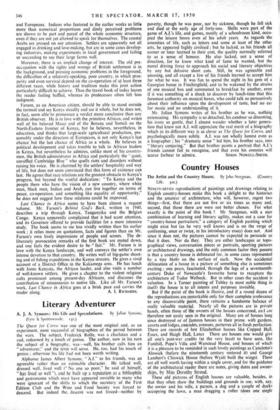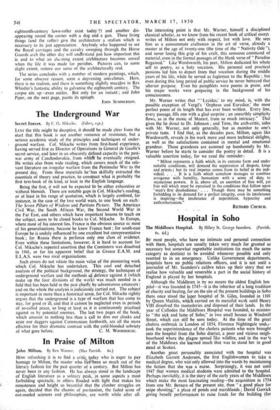Country Houses
The Artist and the Country House. By John Steegman. (Country Life. 3os.) NINETY-SEVEN reproductions of paintings and drawings relating to English country-houses make this book a delight to the historian and the amateur of architecture, who will, however, regret two things—first, that there are not five or six times as many and, second, that those there are were not better chosen. For what exactly is the point of this book ? Mr •Steegman, with a nice combination of learning and literary agility, makes out a case for " country-house portraiture," a category of English painting which might exist but (as he very well knows and is on the verge of confessing, once or twice, in his introductory essay) does not. And since it does not, the pictures cannot be expected to persuade us that it does. Nor do they. They are either landscapes or topo- graphical views, conversation pieces or portraits, sporting pictures or architectural drawings, and the only common factor they possess is that a country house is delineated (or, in some cases represented by a tiny blob) on the surface of each. Now the accidental delineation of a house in a picture of something else is sometimes exciting ; one peers, fascinated, through the legs of a seventeenth- century Duke of Newcastle's favourite horse to recapture the architecture of Tudor Welbeck. But in other cases the accident is valueless. In a Turner painting of Tabley (a most noble thing in itself) the house is to all intents and purposes invisible.
But if the point of the book is illusive, and if a round dozen of the reproductions are remarkable only for their complete irrelevance to any discoverable point, there remains a handsome balance of really valuable material. Nearly all the pictures are in private hands, often those of the owners of the houses concerned, and are therefore not easily seen in the original. Many are of houses long since destroyed or of famous houses in their prime. with gardens, courts and lodges, cascades, avenues, parterres all in fresh perfection. There are records of lost Elizabethan houses like Copped Hall, Essex, and Haigh Hall, Lancs There are houses one would give all one's post-war credits (at the very least) to have seen, like Fonthill, Pope's Villa and Wanstead House, and houses of which it is a pleasure to be reminded in such lovely paintings as Canaletto's Alnwick (before the nineteenth century restored it) and George Lambert's Chiswick House (before Wyatt built the wings). These are all well worth having within a single cover, and for the guidance of the architectural reader there are notes, giving dates and owner- ships, by Miss Dorothy Stroud.
These old pictures, of English houses are valuable, besides, in that they often show the buildings and grounds in use, with, say, the owner and his wife, a parson, a dog and a couple of ducks occupying the lawn, a man dragging a roller (does one single
eighteenth-century lawn-roller exist today ?) and another dis- appearing round the corner with a dog and a gun. These living things (and the roller) give the architecture a realism which is necessary to its just appreciation. Anybody who happened to see the Royal carriages and the cavalry sweeping through the Horse Guards arch the other day will understand just how important this is and to what an ala.-rning extent architecture becomes unreal when the life it was made for perishes. Pictures can, to some slight extent, restore our sense of the architecturally real.
The series concludes with a number of modern paintings, which, for some obscure reason, seem a depressing. anti-climax. Here, there is no realism, and there is something slightly macabre in Rex Whistler's fantastic ability to galvanise the eighteenth century. The corpse sits up—even smiles. But only for an instant ; and John Piper, on the next page, paints its epitaph.
JOHN SUMMERSON.



































 Previous page
Previous page